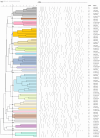Prevalence of Selected Immune Evasion Genes and Clonal Diversity in Methicillin-Susceptible Staphylococcus aureus Isolated from Nasal Carriers and Outpatients with Cut Wound Infections
- PMID: 39200030
- PMCID: PMC11350705
- DOI: 10.3390/antibiotics13080730
Prevalence of Selected Immune Evasion Genes and Clonal Diversity in Methicillin-Susceptible Staphylococcus aureus Isolated from Nasal Carriers and Outpatients with Cut Wound Infections
Abstract
Staphylococcus aureus, being one of the most common human pathogens, is responsible for infections in both hospital and community settings. Its virulence is attributed to its ability to evade the immune system by producing immune evasion (IE) proteins. The aim of this study was to detect the frequency of selected IE genes (spin, sbi, sea, sak, chp, scin, sep, ecb), belonging to the immune evasion cluster (IEC), and IEC types in 86 methicillin-susceptible S. aureus (MSSA) strains isolated from unrelated outpatients. In order to determine the diversity of analyzed strains, the phylogenetic relatedness was also determined. All strains were examined for the presence of IE genes using polymerase chain reaction assay. To analyze the clonal relatedness of S. aureus, pulsed-field gel electrophoresis (PFGE) was performed. All analyzed strains harbored the scn gene, followed by sbi (95.4%), ecb (91.7%), spin (89.5%), sak (83.7%), chp (67.4%), sep (67.4%) and sea (5.8%). Seventy-three (84.9%) S. aureus strains were classified into IEC types, of which, IEC type F was most commonly observed. IEC type A was not detected. PFGE results showed no association between clonal relatedness and the presence of IE genes/IEC types. In conclusion, the abundant and so diverse repertoire of genes determining invasion in analyzed strains may prove the fact that these strains are highly advanced and adapted to evade the host immune response.
Keywords: MSSA; Staphylococcus aureus; clonal diversity; immune evasion; nasal carriers; outpatients; wound infections.
Conflict of interest statement
The authors declare no conflicts of interest.
Figures


Similar articles
-
Molecular analysis of immune evasion cluster (IEC) genes and intercellular adhesion gene cluster (ICA) among methicillin-resistant and methicillin-sensitive isolates of Staphylococcus aureus.J Prev Med Hyg. 2017 Dec 30;58(4):E308-E314. doi: 10.15167/2421-4248/jpmh2017.58.4.711. eCollection 2017 Dec. J Prev Med Hyg. 2017. PMID: 29707662 Free PMC article.
-
Animal and human Staphylococcus aureus associated clonal lineages and high rate of Staphylococcus pseudintermedius novel lineages in Spanish kennel dogs: predominance of S. aureus ST398.Vet Microbiol. 2013 Oct 25;166(3-4):580-9. doi: 10.1016/j.vetmic.2013.07.014. Epub 2013 Jul 22. Vet Microbiol. 2013. PMID: 23932077
-
The innate immune modulators staphylococcal complement inhibitor and chemotaxis inhibitory protein of Staphylococcus aureus are located on beta-hemolysin-converting bacteriophages.J Bacteriol. 2006 Feb;188(4):1310-5. doi: 10.1128/JB.188.4.1310-1315.2006. J Bacteriol. 2006. PMID: 16452413 Free PMC article.
-
Staphylococcus aureus innate immune evasion is lineage-specific: a bioinfomatics study.Infect Genet Evol. 2013 Oct;19:7-14. doi: 10.1016/j.meegid.2013.06.012. Epub 2013 Jun 19. Infect Genet Evol. 2013. PMID: 23792184
-
Prevalence of the immune evasion gene cluster in Staphylococcus aureus CC398.Vet Microbiol. 2015 May 15;177(1-2):219-23. doi: 10.1016/j.vetmic.2015.02.031. Epub 2015 Mar 6. Vet Microbiol. 2015. PMID: 25778546
Cited by
-
Transcriptomic and Biochemical Analysis of the Antimicrobial Mechanism of Lipopeptide Iturin W against Staphylococcus aureus.Int J Mol Sci. 2024 Sep 15;25(18):9949. doi: 10.3390/ijms25189949. Int J Mol Sci. 2024. PMID: 39337437 Free PMC article.
-
Assessment of the biofilm formation capacities of Staphylococcus aureus strains Newman and Newman D2C in vitro and in vivo.Sci Rep. 2025 May 8;15(1):16132. doi: 10.1038/s41598-025-00521-5. Sci Rep. 2025. PMID: 40341159 Free PMC article.
References
-
- Masiuk H., Wcisłek A., Jursa-Kulesza J. Determination of nasal carriage and skin colonization, antimicrobial susceptibility and genetic relatedness of Staphylococcus aureus isolated from patients with atopic dermatitis in Szczecin, Poland. BMC Infect. Dis. 2021;21:701. doi: 10.1186/s12879-021-06382-3. - DOI - PMC - PubMed
Grants and funding
LinkOut - more resources
Full Text Sources
Molecular Biology Databases

